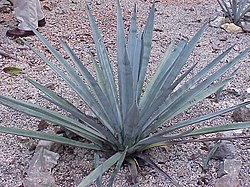Agave syrup
From Wikipedia, the free encyclopedia
Agave syrup (also called agave nectar) is a sweetener commercially produced in Mexico, from several species of agave, including Agave tequilana (also called Blue Agave or Tequila Agave), and the Salmiana, Green, Grey, Thorny, and Rainbow varieties.[1] Agave syrup is sweeter than honey, though less viscous.
Agave syrup is produced in the Mexican States of Jalisco, Michoacán, Guanajuato and Tamaulipas, according to Mexican laws pertaining to certificate of origin, although most is produced in Jalisco.
Contents |
[edit] Production
To produce agave nectar, juice is expressed from the core of the agave, called the piña.[1] The juice is filtered, then heated, to hydrolyze carbohydrates into sugars. The main carbohydrate is a complex form of fructose called inulin or fructosan. The filtered, hydrolyzed juice is concentrated to a syrup-like liquid a little thinner than honey and ranges in color from light to dark depending on the degree of processing. The syrup naturally contains quantities of Iron, Calcium, Potassium & Magnesium which contribute to the resulting color.[citation needed]
An alternative method used to process the agave juice without heat is described in a United States patent for a process that uses enzymes to hydrolyze the polyfructose extract into fructose, using an enzyme derived from Aspergillus niger (black mold). [2] A. niger fermentation is "generally regarded as safe" (GRAS) by the FDA.[3]
[edit] Composition
Agave syrup consists primarily of fructose and glucose. One source[4] gives 92% fructose and 8% glucose; another[5] gives 56% fructose and 20% glucose. These differences presumably reflect variation from one vendor of agave syrup to another. Due to its fructose content and the fact that the glycemic index only measures glucose levels, agave syrup is notable in that its glycemic index and glycemic load are lower than many other natural sweeteners on the market. [6].
However, the extremely high percentage of fructose (higher than that of high-fructose corn syrup) can be deleterious and can trigger fructose malabsorption, metabolic syndrome[7], hypertriglyceridemia, decreased glucose tolerance, hyperinsulinemia, and accelerated uric acid formation.[8][9][10] Low-carb diet advocate Dr. Michael Eades M.D. advises to "avoid it [Agave syrup] like death".[11]
Some criticism [12] has targeted agave syrup. In the late 90s, the agave syrup on the market contained 90% thermally or chemically hydrolyzed fructose, the salmiana variety syrup on the market today is still primarily fructose, but is enzymatically hydrolyzed using a black mold enzyme.[13]
[edit] Culinary use
| This section does not cite any references or sources. Please help improve this article by adding citations to reliable sources (ideally, using inline citations). Unsourced material may be challenged and removed. (February 2008) |
Agave syrup is often substituted for sugar or honey in recipes. Vegans in particular commonly use agave syrup to replace honey in recipes. It is also used as a sweetener for cold beverages such as iced tea because it can dissolve quickly.
Agave nectars are sold in light, amber, dark, and raw varieties. Light agave nectar has a mild, almost neutral flavor, and is therefore sometimes used in delicate tasting foods and drinks. Amber agave nectar has a medium-intensity caramel flavor, and is therefore used in foods and drinks with stronger flavors. Dark agave nectar has stronger caramel notes, and imparts a distinct flavor to dishes, such as some desserts, poultry, meat, and seafood dishes. Both amber and dark agave nectar are sometimes used "straight out of the bottle" as a topping for pancakes and waffles. Raw agave nectar also has a mild, neutral taste. It is produced at temperatures below 118 degrees F to protect the natural enzymes, so this variety is an appropriate sweetener for raw foodists.[14]
[edit] Notes
- ^ a b Blue Agave and Its Importance in the Tequila Industry
- ^ "Method of producing fructose syrup from agave plants (United States Patent 5846333)". 1998-12-08. http://www.patentstorm.us/patents/5846333.html.
- ^ "Inventory of GRAS Notices: Summary of all GRAS Notices". US FDA/CFSAN. 2008-10-22. http://www.cfsan.fda.gov/~rdb/opa-gras.html. Retrieved on 2008-10-31.
- ^ Ronald C. Deis (February 2001). "Sweetners for Health Foods". Food Product Design. http://www.foodproductdesign.com/archive/2001/0201ap.html.
- ^ Ralf Patzold and Hans Bruckner (2005). "Mass Spectrometric Detection and Formation of D-Amino Acids in Processed Plant Saps, Syrups, and Fruit Juice Concentrates". J. Agric. Food Chem 53: 9722−9729. doi:. http://www.uni-giessen.de/fbr09/food/download/Publikationen/J%20agric%20food%20chem%202005%2053%209722-9729_jf051433u.pdf.
- ^ David Mendosa. Revised International Table of Glycemic Index (GI) and Glycemic Load (GL) Values—2002. http://www.mendosa.com/gilists.htm.
- ^ Basciano H, Federico L, Adeli K (2005). "Fructose, insulin resistance, and metabolic dyslipidemia". Nutrition & Metabolism 2 (5). doi:. PMID PMC552336. http://www.pubmedcentral.nih.gov/articlerender.fcgi?tool=pmcentrez&artid=552336.
- ^ Mayes, PA (1993). "Intermediary metabolism of fructose". Am J Clin Nutr. Nov: 58. PMID 8213607. http://www.ncbi.nlm.nih.gov/pubmed/8213607.
- ^ Buemann B, Toubro S, Holst JJ, Rehfeld JF, Bibby BM, Astrup A (2000). "D-tagatose, a stereoisomer of D-fructose, increases blood uric acid concentration". Metabolism Aug (49): 969-76. PMID 10954012. http://www.ncbi.nlm.nih.gov/pubmed/8213607.
- ^ Davis, W (2008). "Yet another reason to avoid fructose". The Heart Scan Blog Dec (6). http://heartscanblog.blogspot.com/2008/12/yet-another-reason-to-avoid-fructose.html.
- ^ Eades, M (2009). "Food trends from Expo West". Michael R. Eades, M.D. Mar (13). http://www.proteinpower.com/drmike/saturated-fat/food-trends-from-expo-west/.
- ^ "Agave Nectar, the High Fructose Health Food Fraud". 2008-11-23. http://www.naturalnews.com/024892.html.
- ^ "Agave Nectar: A Rebuttal to Misinformed Attacks on this Natural Sweetener". 2008-12-11. http://www.naturalnews.com/025060.html.
- ^ Ania Catalano. Baking With Agave Nectar: Over 100 Recipes Using Nature's Ultimate Sweetener, 2008, Celestial Arts, p. ix .
[edit] Bibliography
Mancilla-Margalli, N. A., and M. G. Lopez. "Generation of Maillard Compounds From Inulin During the Thermal Processing of Agave tequilana Weber var. azul. J. Agric. Food Chem. vol. 50 (2002), pp. 806-812.
[edit] See also
- Agave
- Agave americana (AKA Century plant)


